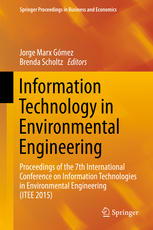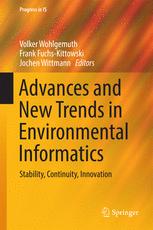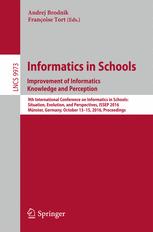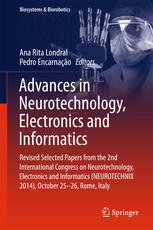Advances and New Trends in Environmental and Energy Informatics Selected and Extended Contributions from the 28th International Conference on Informatics for Environmental Protection 1st edition by Jorge Marx Gomez 9783319234557 3319234552
$50.00 Original price was: $50.00.$25.00Current price is: $25.00.
Advances and New Trends in Environmental and Energy Informatics Selected and Extended Contributions from the 28th International Conference on Informatics for Environmental Protection 1st edition by Jorge Marx Gomez – Ebook PDF Instant Download/Delivery: 9783319234557, 3319234552
Full download Advances and New Trends in Environmental and Energy Informatics Selected and Extended Contributions from the 28th International Conference on Informatics for Environmental Protection 1st edition after payment
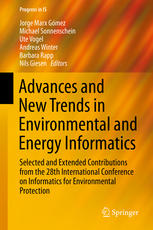
Product details:
• ISBN 10:3319234552
• ISBN 13:9783319234557
• Author:Jorge Marx Gomez
Advances and New Trends in Environmental and Energy Informatics
Selected and Extended Contributions from the 28th International Conference on Informatics for Environmental Protection
This book presents the latest findings and ongoing research in the field of green information systems and green information and communication technology (ICT). It provides insights into a whole range of cross-cutting topics in ICT and environmental sciences as well as showcases how information and communication technologies allow environmental and energy efficiency issues to be handled effectively. The papers presented in this book are a selection of extended and improved contributions to the 28th International Conference on Informatics for Environmental Protection dedicated to ICT for energy efficiency. This book is essential and particularly worth reading for those who already gained basic knowledge and want to deepen and extend their expertise in the subjects mentioned above
Advances and New Trends in Environmental and Energy Informatics Selected and Extended Contributions from the 28th International Conference on Informatics for Environmental Protection 1st Table of contents:
Part I: Green IT
Chapter 1: Extending Energetic Potentials of Data Centers by Resource Optimization to Improve Carbon
1 Introduction
2 Problem Definition
3 Related Work
4 Resource-Efficient and Energy-Adaptive VM Placement Approach
4.1 System Model
4.2 Algorithm
4.3 Future Work and Experiments
5 Conclusion
References
Chapter 2: Expansion of Data Centers´ Energetic Degrees of Freedom to Employ Green Energy Sources
1 Introduction
2 Related Work
3 Models and Simulation Architecture
3.1 Server Models and Application Load
3.2 VM Allocation State
3.3 UPS Models
3.4 Thermal Models
3.5 Network Topology Model
4 Problem Formulation and Methodology
4.1 The DaMucA Heuristic
5 Analysis and Results
6 Conclusion
References
Chapter 3: A Data Center Simulation Framework Based on an Ontological Foundation
1 Introduction
2 Materials and Methods
3 Related Work
4 Simulation Framework
4.1 Data Center Ontology
4.2 Toolbox Ontology and Generation
4.3 Design and Verification
4.4 Operational Simulation Model
4.4.1 Data Center Modelica Package
4.4.2 Operational Data Center Design
4.4.3 Simulation and Visualization
4.4.4 Hardware Profiling
5 Results and Discussion
5.1 Flexibility: Example Scenario
5.2 The Framework in Real-Life Operation
5.3 Further Features
6 Conclusion
References
Chapter 4: The Contexto Framework: Leveraging Energy Awareness in the Development of Context-Aware A
1 Introduction and Motivation
2 Energy Model for the Contexto Framework
3 Implementation
4 Contexto Energy Demand Calculator
5 Evaluation
6 Related Work
7 Future Work
References
Chapter 5: Refactorings for Energy-Efficiency
1 Motivation
2 Basic Techniques
2.1 Reengineering Process
2.2 Evaluation Process
2.2.1 Energy Measurement Techniques
2.2.2 Hardware
2.2.3 Applications
2.2.4 Measurement Procedure
3 Energy Refactoring Catalog
3.1 Energy Code Smell: Data Transfer
3.2 Energy Code Smell: Backlight
3.3 Energy Code Smell: Statement Change
3.4 Energy Code Smell: Third-Party Advertisement
3.5 Energy Code Smell: Binding Resources Too Early
3.6 Further Energy Code Smells
4 Energy Measurements
5 Conclusion
References
Part II: From Smart Grids to Smart Homes
Chapter 6: The 5 % Approach as Building Block of an Energy System Dominated by Renewables
1 Introduction
2 Idea of a Dynamic Intelligent Power Feed-In Management
3 The 5 % Approach
4 Assessment of the Approaches´ Potential by Simulation
4.1 Validating the 5 % Approach in a Field Test
4.2 Field Test Description
4.3 Field Test Results
5 Requirements Toward Control Units Supporting the 5 % Approach
5.1 Control Capabilities Required for the Field Test
6 Control Unit Design
6.1 Interplay Between Control Unit and Generators
7 Related Work
8 Conclusion and Further Work
References
Chapter 7: Aligning IT Architecture Analysis and Security Standards for Smart Grids
1 Introduction
2 Security Architecture Development in the Smart Grid
2.1 Results from the SGIS Group
2.2 The Smart Grid Architecture Model (SGAM)
2.3 Security Standards: NISTIR 7628
2.4 Analysis of Linking the NISTIR 7628 and SGAM
2.5 Linking Architecture and Security
3 Example Use Case “Control of DER´´
3.1 Identifying and (Formally) Specifying the Use Case in IEC PAS 62559 Templates
3.2 Identification and Mapping of Systems, LIs and Interface Categories
3.3 Integration of the Systems and the LIs onto the SGAM Functional Layer
3.4 Using the SG-CySecReq Annex from NISTIR 7628
3.5 Mapping Additional SGAM Layers
4 Utilization of Maturity Models in Security Contexts
4.1 Maturity Models
4.2 Ideas of Combining Security and Maturity Models
4.3 Example: Situational Awareness
5 Conclusion and Further Work
References
Chapter 8: Design, Analysis and Evaluation of Control Algorithms for Applications in Smart Grids
1 Introduction
2 Conceptualize: Trading Flexibility as Business Case
3 Design: Predictive Scheduling by Distributed Control
3.1 The SGAM Layers
4 Analysis and Evaluation from a General Perspective
4.1 Zeroth-Order Criteria
4.2 First-Order Criteria
4.3 Higher-Order Criteria
5 Analyze: Deriving Performance Guarantees
5.1 Methodical Aspects
5.2 Application to the COHDA Algorithm
6 Evaluation
6.1 Methodical Aspects
6.2 Application to the COHDA Algorithm
7 Conclusion
References
Chapter 9: Multi-actor Urban Energy Planning Support: Building Refurbishment and Building-Integrated
1 Introduction
2 Objectives
3 Methodology and Application
3.1 Scoping Phase
3.2 Data Availability Check
3.3 Computation Models Check/Data Modelling
3.4 Computation Models Development
3.5 Interaction Modeling
3.6 Decision Modeling
3.7 Data Integration
3.8 Data Use
4 Building Refurbishment Planning Integration
5 Conclusion
References
Chapter 10: Beyond Eco-feedback: Using Room as a Context to Design New Eco-support Features at Home
1 Introduction
2 Eco Support Systems
2.1 Eco-Feedback
2.2 Eco-Control
2.3 Eco-Automation
2.4 Using Context in Eco Design
3 Room as a Context: A Conceptual View
3.1 Room as a Domestic Order for Everyday Activates
3.2 Placing and Spacing: A New View on Domestic Indoor Location
3.3 Understanding of Energy Consumption and Energy Wastage
3.4 Room-Context Aware Feedback
3.5 Room-Context Aware Home Control
3.6 Room-Context Aware Home Automation
4 Room as a Context: Realization of Design Implication
4.1 Contextualized Eco-Feedback
4.2 Contextualized Eco-Control
4.3 Contextualize Eco-Automation
5 Evaluation
6 Discussion and Outlook
References
Part III: Smart Transportation
Chapter 11: Supporting Sustainable Mobility Using Mobile Technologies and Personalized Environmental
1 Introduction
1.1 Supporting Sustainable Mobility in Oslo
2 Citi-Sense-MOB Architecture
2.1 Design of Services
2.2 Sensor Platforms
2.3 Online Data Visualization
2.4 Social Networks
3 Preliminary Results
3.1 Stakeholder Engagement
3.2 Social Networks
3.3 Mobile Phone Application
4 Performance of the Sensor Platform
4.1 Road Trials
5 Conclusions
References
Chapter 12: Spatial Information for Safer Bicycling
1 The Bicycle as Sustainable Mode of Transport
1.1 Bicycle Traffic and Safety Concerns
1.2 Improving Bicycle Safety
2 What GIS Can Offer
2.1 Spatio-Temporal Accident Analysis
2.2 Assessing Quality of Road Network in Terms of Safety
2.3 Spatial Simulation for Safety Improvement
2.4 Planning Bicycle Corridors
2.5 Routing
2.6 Communication
3 Conclusion and Outlook
References
Chapter 13: Using Systems Thinking and System Dynamics Modeling to Understand Rebound Effects
1 Introduction
2 Main Concepts
2.1 Rebound Effects
2.2 Systems Thinking and Modeling
3 Selected Models
4 Model 1: Future Impacts of ICT on Environmental Sustainability: Submodel Passenger Transport (IPTS
4.1 Direct Economic Rebound Effects in Model 1
4.2 Time Rebound Effect in Model 1
5 Model 2: Tourism Transport, Efficiency, and GHG Emissions
5.1 Direct Economic Rebound Effect in Model 2
5.2 Time Rebound Effects in Model 2
6 Main Findings and Discussion
6.1 Main Findings from Reviewing Model 1 and Model 2
6.2 Time Rebound
6.3 Critique of the Travel Time Budget Approach
6.4 Quantification of Rebound Effects
6.5 System Archetypes for Rebound Effects
6.6 Contribution of Systems Thinking and Modeling to Rebound Analysis
7 Conclusions
References
Part IV: Sustainable Enterprises and Management
Chapter 14: Software and Web-Based Tools for Sustainability Management in Micro-, Small- and Medium-
1 Introduction
2 Web-Based Tools for German SMEs
3 Theoretical Background
4 Survey Methodology and Results
5 Web-Based Tool for Micro-enterprises
6 Sustainability Quick-Check
7 Conclusions
References
Chapter 15: Towards Collaborative Green Business Process Management as a Conceptual Framework
1 Introduction
2 Sustainability in BPM and Organizational Development
2.1 Energy Feedback for Behavioral Change
2.2 BPM for Organizational Sustainability
3 Collaboration in Green Process Management
3.1 Understanding Needs in Practice
3.2 Envisioning Co-GreenBPM
3.3 Envisioning Tools and Methods
4 Discussion and Research Agenda
References
Part V: Environmental Decision Support
Chapter 16: A Generic Decision Support System for Environmental Policy Making: Attributes, Initial F
1 Introduction
2 Methodology and Process Model
3 D2S4E Major Attributes
3.1 Integrated Evaluation of Environmental Issues
3.1.1 Integration of Disciplines
3.1.2 Integration with Stakeholders
3.2 A System Dynamics Approach to Model Complex Environmental Issues
4 Preliminary Findings from Pilot Deployment
5 Challenges Faced
5.1 Communication with End Users
5.2 Data and Knowledge Quality Versus Scope of Analysis
5.3 Environmental Data and Indicator Framework
5.4 Lack of Synergy Between Regional Project Implementations
6 Conclusion
References
Chapter 17: Towards an Environmental Decision-Making System: A Vocabulary to Enrich Stream Data
1 Introduction
2 Related Work
3 Ontology for Modeling Environmental Data Streams
3.1 Requirements
3.2 Reused Ontologies
3.3 Considerations
3.3.1 Decisions Between Ontology Alternatives
3.3.2 Reusing Ontologies
3.3.3 Storing Spatial and Temporal Observation Data
3.3.4 Defining the Measure Property According to QB
4 Architecture
4.1 Data Acquisition and Data Transformation
4.2 Data Streaming
4.3 Semantic Modeling of Stream Data
5 Mashup Based on Linked Streaming Widgets
6 Conclusions and Future Work
References
Chapter 18: How a Computational Method Can Help to Improve the Quality of River Flood Prediction by
1 Motivation
2 The Flood Wave Simulator
2.1 Modelling Overview
2.2 Model Uncertainties
2.3 The Computational Model
3 Paran River Model
4 The Optimization Scheme
4.1 Parametric Simulation
4.2 Optimization Overview
4.3 The Search Procedure
4.4 Problem Delineation
5 Experimental Results
6 Results and Conclusions
References
Part VI: Social Media for Sustainability
Chapter 19: A Social Media Environmental Awareness Campaign to Promote Sustainable Practices in Educ
1 Introduction
2 Literature Review
2.1 Environmental Knowledge and Awareness
2.2 Environmental Education
2.3 Effectiveness of Social Media for Information Sharing
3 Research Methodology and Objectives
4 Findings
4.1 Growth in Environmental Knowledge
4.2 Social Media Campaign Usage
5 Recommendations and Conclusion
References
Chapter 20: Supporting Sustainable Development in Rural Areas by Encouraging Local Cooperation and N
1 Demographic Problems in Rural Areas in Europe
2 Supporting Local Cooperation Using ICT
2.1 Conceptual Development
2.1.1 Analysis of Existing Regional Platforms
2.1.2 Assessment Survey
2.1.3 Screen Design Concept
2.1.4 Use Case Development
2.2 Prototypical Implementation
2.2.1 Data Self-Management
2.2.2 Usability and Adaption Cycle
2.3 Website Release
2.4 Mobile Application Release
2.5 Usage Analysis
3 Summary and Outlook
References
People also search for Advances and New Trends in Environmental and Energy Informatics Selected and Extended Contributions from the 28th International Conference on Informatics for Environmental Protection 1st:
advances and new trends in environmental
advances and new trends in environmental informatics
advances and new trends in environmental information
what are the latest environmental trends
what are the new trends in psychology
You may also like…
Engineering - Environmental
Business & Economics
Engineering - Environmental
Computers - Computer Science
Engineering
Advances in Materials Science for Environmental and Energy Technologies VI 1st Edition Tatsuki Ohji




